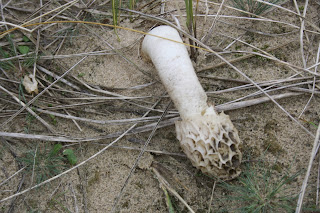The breeding Grey Seal colony (rookery) on Blakeney Point appeared in autumn 2001. The occasional pup had been recorded previously, for example on the landing ridge in the 1990s. But it was in 2001 that the rookery first developed, with 25 pups born. This doubled the following winter and had doubled again to 100 two years later. Numbers have continued to increase every year.
This autumn, for the first time counts seemed to be lagging behind the previous year. Counts last week were typically about 50 less than the same date last year. This may be because the pupping season started a few days later than normal.
However, numbers have started to accelerate over the past few days, with 105 pups born between Saturday afternoon and Sunday afternoon. We seem to have finally caught up with last year's figures and may well be about to overtake them. Only time will tell.
We are now reaching the point where the first born pups of the season have shed their white fur, and some cows are starting to look noticeably thin. Having been fed on their mother's rich milk for three weeks, the older pups are being left to their own devices. The time has come for them to go into the sea and find food for themselves.
National Trust volunteer and student, Olivia Berry, recently spent an hour taking photographs from the edge of the rookery. She was careful not to cause any disturbance and captured some great pictures.
This autumn, for the first time counts seemed to be lagging behind the previous year. Counts last week were typically about 50 less than the same date last year. This may be because the pupping season started a few days later than normal.
Date
|
2012 pup
count
|
2013 pup
count
|
27th Oct
|
1
|
0
|
29th Oct
|
5
|
0
|
30th Oct
|
1
| |
7th Nov
|
91
|
29
|
13th Nov
|
252
|
202
|
14th Nov
|
293
|
236
|
19th Nov
|
475
|
423
|
However, numbers have started to accelerate over the past few days, with 105 pups born between Saturday afternoon and Sunday afternoon. We seem to have finally caught up with last year's figures and may well be about to overtake them. Only time will tell.
Date
|
2012
pup count
|
2013
pup count
|
20th
Nov
|
466
|
|
21st
Nov
|
593
|
|
22nd
Nov
|
589
|
|
23rd
Nov
|
725
|
|
24th
Nov
|
830
|
|
28th
Nov
|
889
|
Watch this space
|
A plump pup that will soon be swimming
National Trust volunteer and student, Olivia Berry, recently spent an hour taking photographs from the edge of the rookery. She was careful not to cause any disturbance and captured some great pictures.
With such large numbers of seals at the western end of the Point, it is important not to walk amongst them. Nobody wants to be bitten by a seal or cause a pup to get crushed by an adult. Great views from a safe distance are possible from the end of the boardwalk, old Tern Hide and "Sea Hide". Please refer to signage and do not cross the fenceline.
.
It is not only seals that have caused excitement this week. At about 3.30pm on Monday (the 18th), Paul saw a Yellow-breasted Bunting in the garden. This is a great record for Blakeney Point. These buntings are summer visitors to Europe, spending winter in southeast Asia, they are a real rarity in Britain (the only other British record this year was on the Farne Islands, in early September, they currently have 1,336 Grey Seal pups). Unfortunately, its stay was brief and hopeful birdwatchers walking up early the next morning were sadly unlucky.
Flocks of Snow Buntings are seen every day on the Point at the moment, a peak of 85 were recorded earlier this week.
A female Blackcap was seen on Monday and two Chiffchaffs in the Plantation on Friday. Six Twite were reported on Friday.
- Ajay Tegala, Coastal Ranger
It is not only seals that have caused excitement this week. At about 3.30pm on Monday (the 18th), Paul saw a Yellow-breasted Bunting in the garden. This is a great record for Blakeney Point. These buntings are summer visitors to Europe, spending winter in southeast Asia, they are a real rarity in Britain (the only other British record this year was on the Farne Islands, in early September, they currently have 1,336 Grey Seal pups). Unfortunately, its stay was brief and hopeful birdwatchers walking up early the next morning were sadly unlucky.
Flocks of Snow Buntings are seen every day on the Point at the moment, a peak of 85 were recorded earlier this week.
Snow Buntings at sunset
A female Blackcap was seen on Monday and two Chiffchaffs in the Plantation on Friday. Six Twite were reported on Friday.
On Thursday a group of noisy Herring Gulls were seen above the beach marauding a lone Starling. One made a grab for it and caught it, then a squabble broke out. The poor Starling was dropped into the water and then caught again. Other interesting Herring Gull behaviour has been witnessed amongst the rookery. There are a couple of juveniles with injured wings that spend their time walking around feeding on seal after-birth, one of them has been present for well over a week now, clearly finding plenty to eat without the aid of flight to find food. It is not just gulls that have been seen feeding on after-birth, on Friday a Sanderling was seen happily feeding a few inches from a newborn pup...
(Photograph by Graham Lubbock)
During this afternoon's count, two pups were both seen trying to suckle from the same cow at the same time...
- Ajay Tegala, Coastal Ranger






















